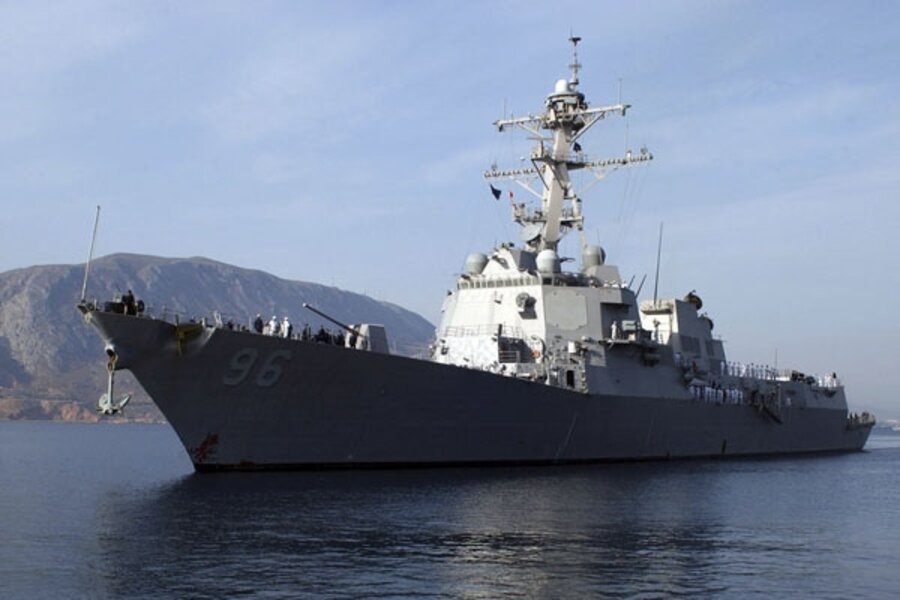Standoff with Somali pirates shows limits of naval response
Loading...
| Nairobi, Kenya
As the standoff between the US Navy and Somali pirates intensified Friday in the Indian Ocean, with pirates vowing to fight on as the US encircled them, analysts were pointing to the episode as evidence that international naval power may have a limited role in ridding the seas of the pirate scourge.
Central to stemming the attacks is addressing issues in Somalia, where the weak government is powerless to intervene without substantial financial and logistical support from donor countries.
“Twenty years ago we had a strong government, with maritime forces and armed forces, and ships to defend our waters," says Abdi Haji Gobdoon, spokesman for the Somali government. “There was never any problem like this.”
“At the moment, we have no ability to protect the waters or defend against the pirates,” he said by telephone from the Somali capital. The fledgling government controls only a small portion of the capital, let alone its 1,879 miles of coastline. He added that requests for financial assistance or technical help had been made repeatedly to donor nations, but continued to fall on deaf ears.
“No one wants to help us with this. I don’t know why, because it is a problem for everyone now,” he said. “They send ships but we need stability on land.”
Somalia has had no effective government since 1991. With no coast guard or military to defend its territorial waters, Somalis, whose livelihoods depended on fishing, could only watch as foreign trawlers emptied the seas of fish. To survive, many took up piracy instead.
Last year was a bumper year for Somali pirates, who hijacked more than 40 vessels and earned millions of dollars in ransom in a country riddled with drought, war, and poverty. The intensified attacks have prompted an international response, with more than 12 governments sending warships to patrol the busy shipping lanes through the Gulf of Aden last year.
But this year, the pirates have begun attacking further afield to evade capture. And they captured the world’s attention this week when four pirates boarded a US-flagged container ship, the Maersk Alabama, Wednesday after a high-speed chase. That attack was the sixth such strike over the past week.
The 20-man crew eventually managed to overpower their attackers on Wednesday. But in a dramatic twist, the captain of the Danish-operated vessel, Richard Phillips, handed himself over to the gunmen to secure the safety of his crew.
He has spent the past 48 hours adrift in a lifeboat with his captors as the US Navy, in the form of a guided missile destroyer, the USS Bainbridge, keeps a close watch. Friday morning, Captain Phillips attempted to escape, but was recaptured by the pirates. Even as the US sent reinforcements to the area, pirates were doing the same, with Reuters reporting that skiffs and motherships were heading to the area, including four foreign ships that had been captured. A total of 54 hostages are on two of the ships, citizens of China, Germany, Russia, Ukraine, the Philippines, Tuvalu, Indonesia, and Taiwan, Reuters reported.
The Maersk Alabama, which is carrying food aid for Uganda and Somalia, is now on its way to its original destination, Mombasa port in Kenya. It is expected to arrive by Sunday night.
As more warships make their way to the area, they can only sit and watch as negotiations continue for the release of Captain Phillips, the first American snatched by pirates in 200 years. On Thursday, FBI negotiators were brought in to help.
The standoff gives President Barack Obama a foreign policy dilemma as his administration weighs the options for tackling piracy.
Rashid Abdi Sheikh, Somalia analyst with the International Crisis Group in Nairobi, says using military options could only make things worse if they did not go hand-in-hand with political solutions.
“Most of these pirates are operating from the region of Puntland, which is essentially a failed state within a failed state,” he says.
“Nothing will change until we see more stability on land.”
For the time being, though, sending warships remains the preferred strategy rather than sending cash to a government headed by Sheikh Sharif Sheikh Ahmed - chased from Mogadishu just over two years ago when he was one of two leaders of Somalia’s Islamic Courts.
Once pirates have taken control of a vessel, though, the warships are often powerless to intervene. Negotiated settlements offer less risk of harming the crew.
Instead the warships are there to deter attacks where possible.
Last year the United Nations Security Council adopted an American-drafted resolution allowing countries to pursue Somali pirates on land as well as at sea.
The US has launched missile strikes against Islamist targets in the past two years and officials have suggested the same strategy could be used to knock out pirate havens.
But Bruno Schiemsky, a military analyst in Nairobi who monitors Somalia, said the strategy was unworkable without much better intelligence.
“What are they going to do? It’s not as if you can put a missile on the head of each pirate. You’d have to take out entire towns or villages.”





